Negligence in Tort Law: Elements, Standards, and Damages
VerifiedAdded on 2023/04/22
|6
|1862
|296
AI Summary
This article discusses the concept of negligence in tort law, its essential elements, standards of care, and damages. It includes a case study on Noreen's wrongful act and its claims in negligence. The article also covers the duty of care, breach of duty, and the 'but for' test for establishing damages.
Contribute Materials
Your contribution can guide someone’s learning journey. Share your
documents today.
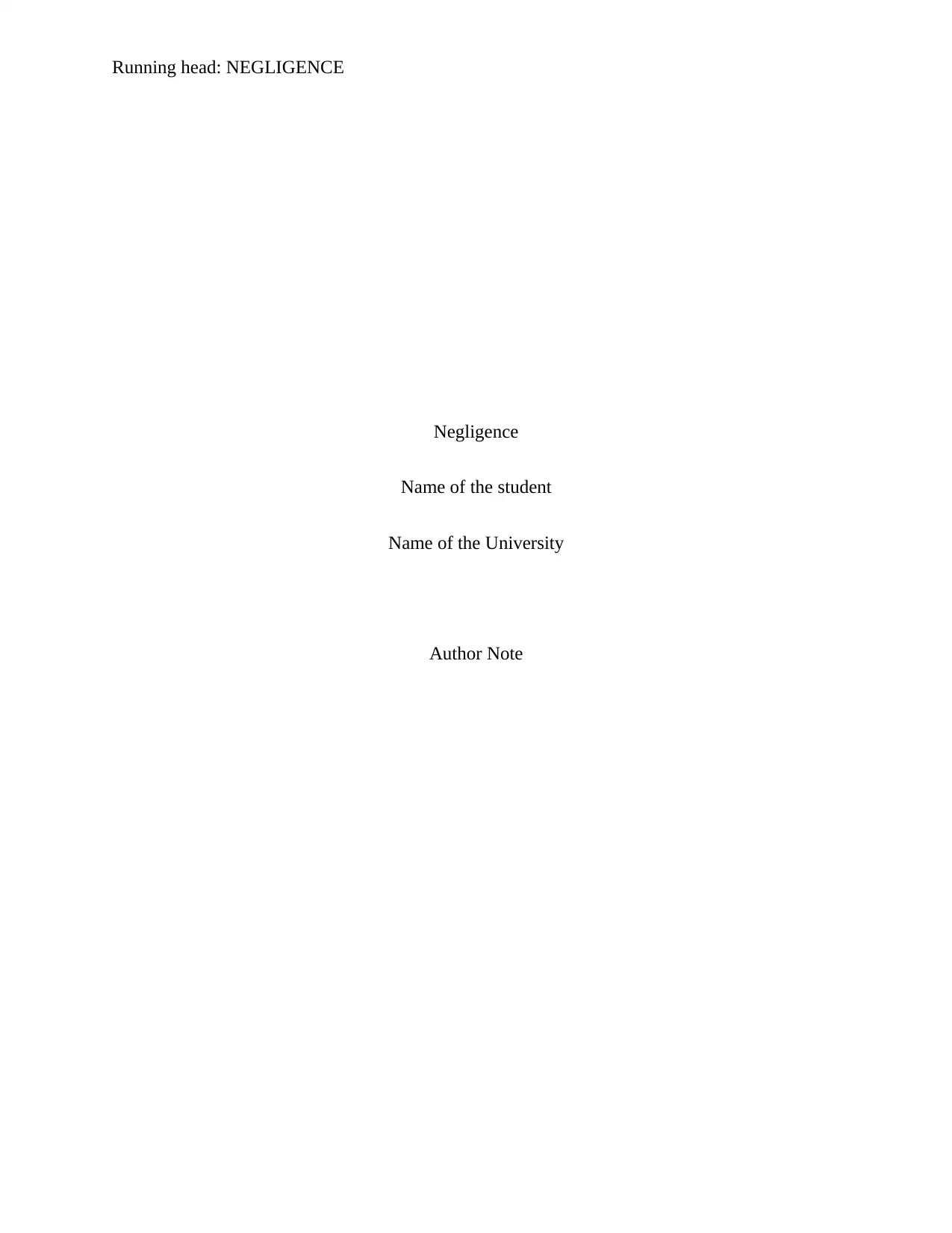
Running head: NEGLIGENCE
Negligence
Name of the student
Name of the University
Author Note
Negligence
Name of the student
Name of the University
Author Note
Secure Best Marks with AI Grader
Need help grading? Try our AI Grader for instant feedback on your assignments.
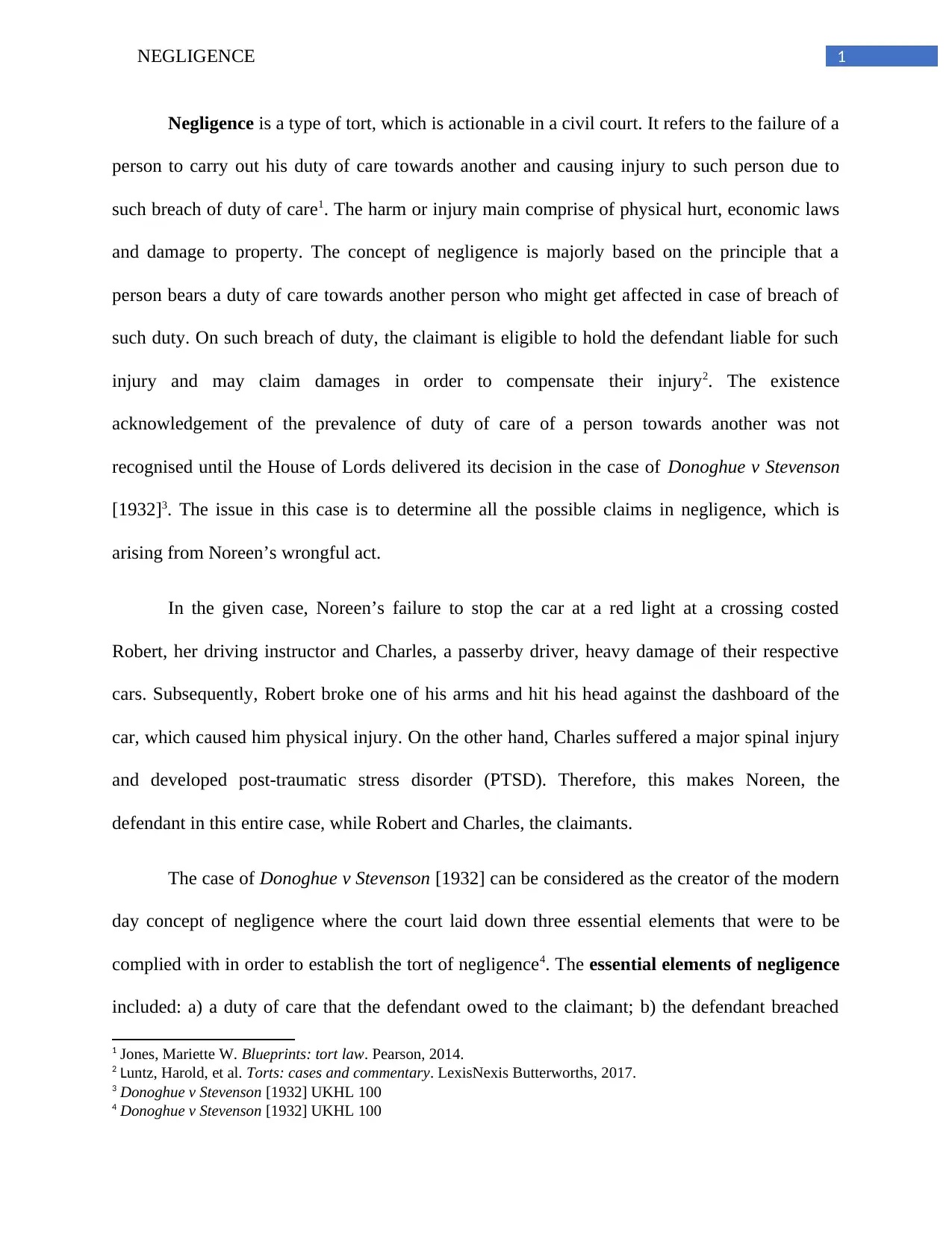
1NEGLIGENCE
Negligence is a type of tort, which is actionable in a civil court. It refers to the failure of a
person to carry out his duty of care towards another and causing injury to such person due to
such breach of duty of care1. The harm or injury main comprise of physical hurt, economic laws
and damage to property. The concept of negligence is majorly based on the principle that a
person bears a duty of care towards another person who might get affected in case of breach of
such duty. On such breach of duty, the claimant is eligible to hold the defendant liable for such
injury and may claim damages in order to compensate their injury2. The existence
acknowledgement of the prevalence of duty of care of a person towards another was not
recognised until the House of Lords delivered its decision in the case of Donoghue v Stevenson
[1932]3. The issue in this case is to determine all the possible claims in negligence, which is
arising from Noreen’s wrongful act.
In the given case, Noreen’s failure to stop the car at a red light at a crossing costed
Robert, her driving instructor and Charles, a passerby driver, heavy damage of their respective
cars. Subsequently, Robert broke one of his arms and hit his head against the dashboard of the
car, which caused him physical injury. On the other hand, Charles suffered a major spinal injury
and developed post-traumatic stress disorder (PTSD). Therefore, this makes Noreen, the
defendant in this entire case, while Robert and Charles, the claimants.
The case of Donoghue v Stevenson [1932] can be considered as the creator of the modern
day concept of negligence where the court laid down three essential elements that were to be
complied with in order to establish the tort of negligence4. The essential elements of negligence
included: a) a duty of care that the defendant owed to the claimant; b) the defendant breached
1 Jones, Mariette W. Blueprints: tort law. Pearson, 2014.
2 Luntz, Harold, et al. Torts: cases and commentary. LexisNexis Butterworths, 2017.
3 Donoghue v Stevenson [1932] UKHL 100
4 Donoghue v Stevenson [1932] UKHL 100
Negligence is a type of tort, which is actionable in a civil court. It refers to the failure of a
person to carry out his duty of care towards another and causing injury to such person due to
such breach of duty of care1. The harm or injury main comprise of physical hurt, economic laws
and damage to property. The concept of negligence is majorly based on the principle that a
person bears a duty of care towards another person who might get affected in case of breach of
such duty. On such breach of duty, the claimant is eligible to hold the defendant liable for such
injury and may claim damages in order to compensate their injury2. The existence
acknowledgement of the prevalence of duty of care of a person towards another was not
recognised until the House of Lords delivered its decision in the case of Donoghue v Stevenson
[1932]3. The issue in this case is to determine all the possible claims in negligence, which is
arising from Noreen’s wrongful act.
In the given case, Noreen’s failure to stop the car at a red light at a crossing costed
Robert, her driving instructor and Charles, a passerby driver, heavy damage of their respective
cars. Subsequently, Robert broke one of his arms and hit his head against the dashboard of the
car, which caused him physical injury. On the other hand, Charles suffered a major spinal injury
and developed post-traumatic stress disorder (PTSD). Therefore, this makes Noreen, the
defendant in this entire case, while Robert and Charles, the claimants.
The case of Donoghue v Stevenson [1932] can be considered as the creator of the modern
day concept of negligence where the court laid down three essential elements that were to be
complied with in order to establish the tort of negligence4. The essential elements of negligence
included: a) a duty of care that the defendant owed to the claimant; b) the defendant breached
1 Jones, Mariette W. Blueprints: tort law. Pearson, 2014.
2 Luntz, Harold, et al. Torts: cases and commentary. LexisNexis Butterworths, 2017.
3 Donoghue v Stevenson [1932] UKHL 100
4 Donoghue v Stevenson [1932] UKHL 100
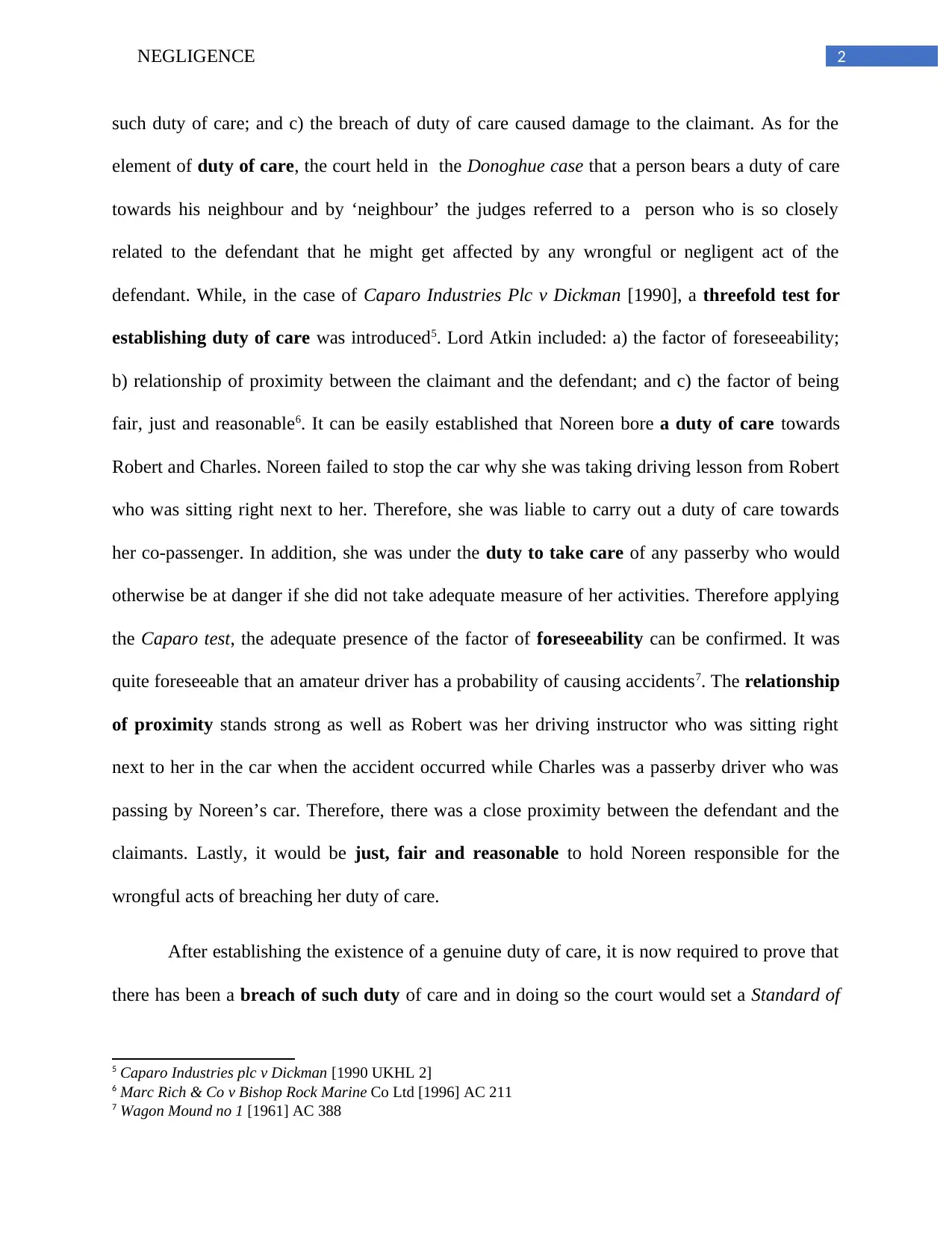
2NEGLIGENCE
such duty of care; and c) the breach of duty of care caused damage to the claimant. As for the
element of duty of care, the court held in the Donoghue case that a person bears a duty of care
towards his neighbour and by ‘neighbour’ the judges referred to a person who is so closely
related to the defendant that he might get affected by any wrongful or negligent act of the
defendant. While, in the case of Caparo Industries Plc v Dickman [1990], a threefold test for
establishing duty of care was introduced5. Lord Atkin included: a) the factor of foreseeability;
b) relationship of proximity between the claimant and the defendant; and c) the factor of being
fair, just and reasonable6. It can be easily established that Noreen bore a duty of care towards
Robert and Charles. Noreen failed to stop the car why she was taking driving lesson from Robert
who was sitting right next to her. Therefore, she was liable to carry out a duty of care towards
her co-passenger. In addition, she was under the duty to take care of any passerby who would
otherwise be at danger if she did not take adequate measure of her activities. Therefore applying
the Caparo test, the adequate presence of the factor of foreseeability can be confirmed. It was
quite foreseeable that an amateur driver has a probability of causing accidents7. The relationship
of proximity stands strong as well as Robert was her driving instructor who was sitting right
next to her in the car when the accident occurred while Charles was a passerby driver who was
passing by Noreen’s car. Therefore, there was a close proximity between the defendant and the
claimants. Lastly, it would be just, fair and reasonable to hold Noreen responsible for the
wrongful acts of breaching her duty of care.
After establishing the existence of a genuine duty of care, it is now required to prove that
there has been a breach of such duty of care and in doing so the court would set a Standard of
5 Caparo Industries plc v Dickman [1990 UKHL 2]
6 Marc Rich & Co v Bishop Rock Marine Co Ltd [1996] AC 211
7 Wagon Mound no 1 [1961] AC 388
such duty of care; and c) the breach of duty of care caused damage to the claimant. As for the
element of duty of care, the court held in the Donoghue case that a person bears a duty of care
towards his neighbour and by ‘neighbour’ the judges referred to a person who is so closely
related to the defendant that he might get affected by any wrongful or negligent act of the
defendant. While, in the case of Caparo Industries Plc v Dickman [1990], a threefold test for
establishing duty of care was introduced5. Lord Atkin included: a) the factor of foreseeability;
b) relationship of proximity between the claimant and the defendant; and c) the factor of being
fair, just and reasonable6. It can be easily established that Noreen bore a duty of care towards
Robert and Charles. Noreen failed to stop the car why she was taking driving lesson from Robert
who was sitting right next to her. Therefore, she was liable to carry out a duty of care towards
her co-passenger. In addition, she was under the duty to take care of any passerby who would
otherwise be at danger if she did not take adequate measure of her activities. Therefore applying
the Caparo test, the adequate presence of the factor of foreseeability can be confirmed. It was
quite foreseeable that an amateur driver has a probability of causing accidents7. The relationship
of proximity stands strong as well as Robert was her driving instructor who was sitting right
next to her in the car when the accident occurred while Charles was a passerby driver who was
passing by Noreen’s car. Therefore, there was a close proximity between the defendant and the
claimants. Lastly, it would be just, fair and reasonable to hold Noreen responsible for the
wrongful acts of breaching her duty of care.
After establishing the existence of a genuine duty of care, it is now required to prove that
there has been a breach of such duty of care and in doing so the court would set a Standard of
5 Caparo Industries plc v Dickman [1990 UKHL 2]
6 Marc Rich & Co v Bishop Rock Marine Co Ltd [1996] AC 211
7 Wagon Mound no 1 [1961] AC 388
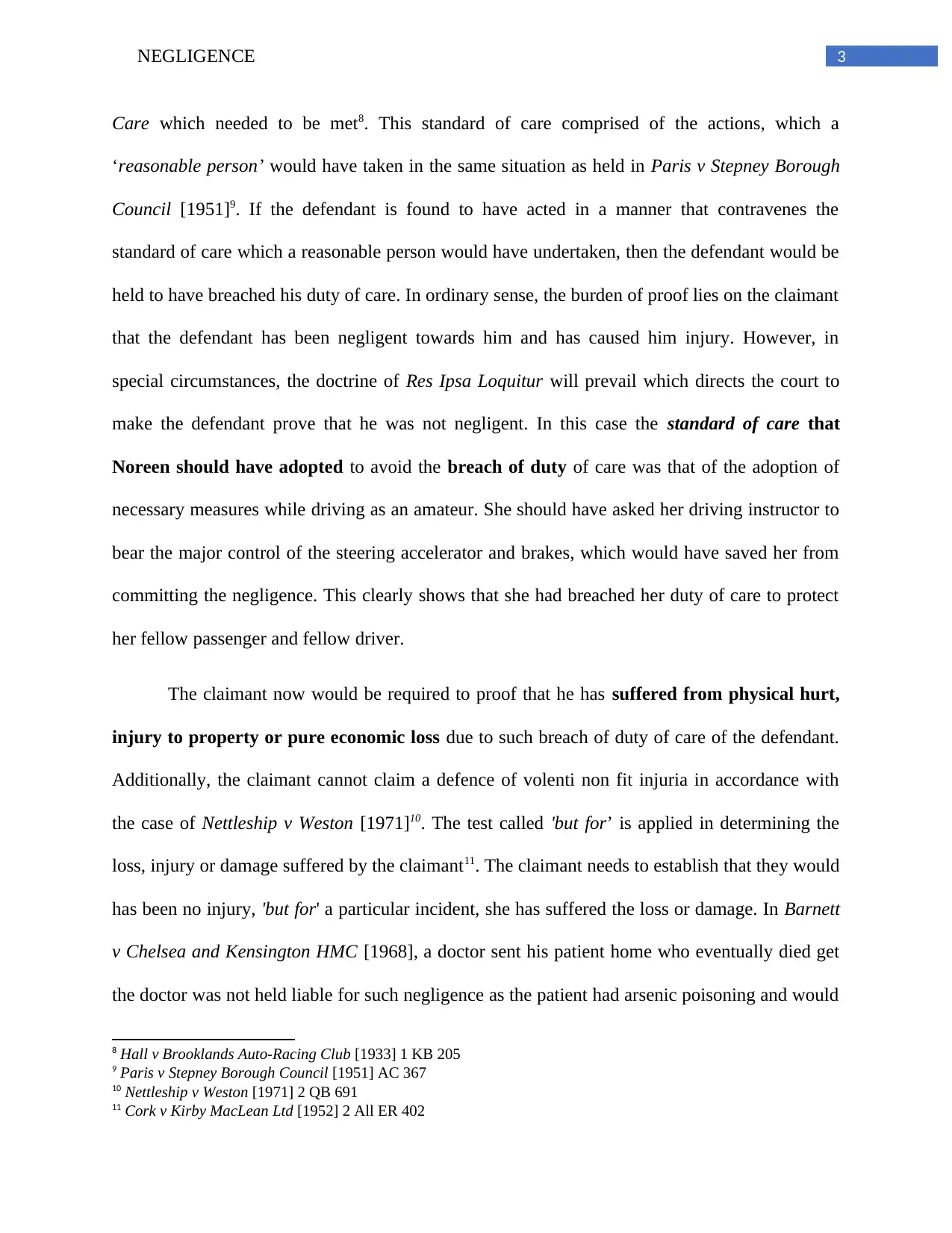
3NEGLIGENCE
Care which needed to be met8. This standard of care comprised of the actions, which a
‘reasonable person’ would have taken in the same situation as held in Paris v Stepney Borough
Council [1951]9. If the defendant is found to have acted in a manner that contravenes the
standard of care which a reasonable person would have undertaken, then the defendant would be
held to have breached his duty of care. In ordinary sense, the burden of proof lies on the claimant
that the defendant has been negligent towards him and has caused him injury. However, in
special circumstances, the doctrine of Res Ipsa Loquitur will prevail which directs the court to
make the defendant prove that he was not negligent. In this case the standard of care that
Noreen should have adopted to avoid the breach of duty of care was that of the adoption of
necessary measures while driving as an amateur. She should have asked her driving instructor to
bear the major control of the steering accelerator and brakes, which would have saved her from
committing the negligence. This clearly shows that she had breached her duty of care to protect
her fellow passenger and fellow driver.
The claimant now would be required to proof that he has suffered from physical hurt,
injury to property or pure economic loss due to such breach of duty of care of the defendant.
Additionally, the claimant cannot claim a defence of volenti non fit injuria in accordance with
the case of Nettleship v Weston [1971]10. The test called 'but for’ is applied in determining the
loss, injury or damage suffered by the claimant11. The claimant needs to establish that they would
has been no injury, 'but for' a particular incident, she has suffered the loss or damage. In Barnett
v Chelsea and Kensington HMC [1968], a doctor sent his patient home who eventually died get
the doctor was not held liable for such negligence as the patient had arsenic poisoning and would
8 Hall v Brooklands Auto-Racing Club [1933] 1 KB 205
9 Paris v Stepney Borough Council [1951] AC 367
10 Nettleship v Weston [1971] 2 QB 691
11 Cork v Kirby MacLean Ltd [1952] 2 All ER 402
Care which needed to be met8. This standard of care comprised of the actions, which a
‘reasonable person’ would have taken in the same situation as held in Paris v Stepney Borough
Council [1951]9. If the defendant is found to have acted in a manner that contravenes the
standard of care which a reasonable person would have undertaken, then the defendant would be
held to have breached his duty of care. In ordinary sense, the burden of proof lies on the claimant
that the defendant has been negligent towards him and has caused him injury. However, in
special circumstances, the doctrine of Res Ipsa Loquitur will prevail which directs the court to
make the defendant prove that he was not negligent. In this case the standard of care that
Noreen should have adopted to avoid the breach of duty of care was that of the adoption of
necessary measures while driving as an amateur. She should have asked her driving instructor to
bear the major control of the steering accelerator and brakes, which would have saved her from
committing the negligence. This clearly shows that she had breached her duty of care to protect
her fellow passenger and fellow driver.
The claimant now would be required to proof that he has suffered from physical hurt,
injury to property or pure economic loss due to such breach of duty of care of the defendant.
Additionally, the claimant cannot claim a defence of volenti non fit injuria in accordance with
the case of Nettleship v Weston [1971]10. The test called 'but for’ is applied in determining the
loss, injury or damage suffered by the claimant11. The claimant needs to establish that they would
has been no injury, 'but for' a particular incident, she has suffered the loss or damage. In Barnett
v Chelsea and Kensington HMC [1968], a doctor sent his patient home who eventually died get
the doctor was not held liable for such negligence as the patient had arsenic poisoning and would
8 Hall v Brooklands Auto-Racing Club [1933] 1 KB 205
9 Paris v Stepney Borough Council [1951] AC 367
10 Nettleship v Weston [1971] 2 QB 691
11 Cork v Kirby MacLean Ltd [1952] 2 All ER 402
Secure Best Marks with AI Grader
Need help grading? Try our AI Grader for instant feedback on your assignments.
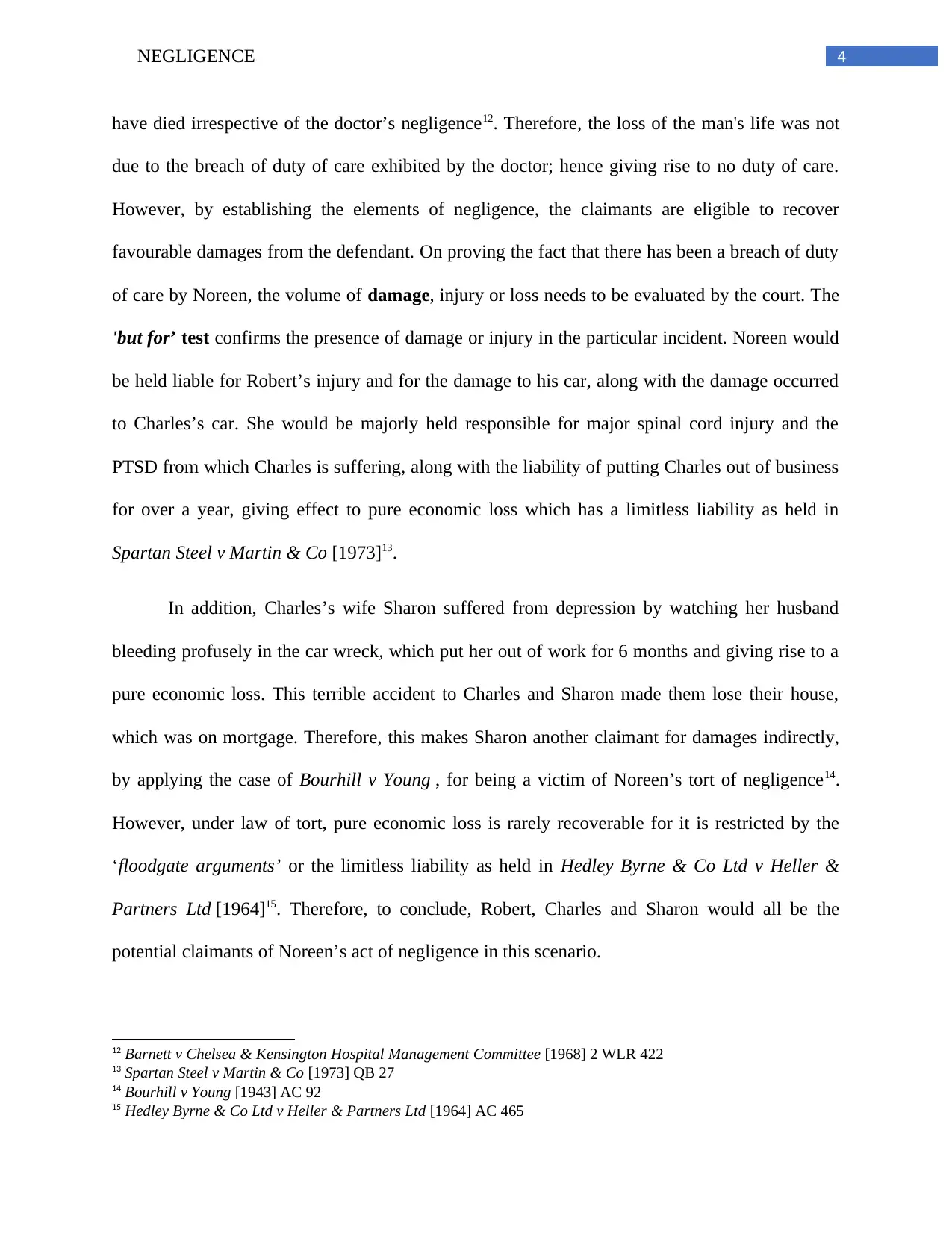
4NEGLIGENCE
have died irrespective of the doctor’s negligence12. Therefore, the loss of the man's life was not
due to the breach of duty of care exhibited by the doctor; hence giving rise to no duty of care.
However, by establishing the elements of negligence, the claimants are eligible to recover
favourable damages from the defendant. On proving the fact that there has been a breach of duty
of care by Noreen, the volume of damage, injury or loss needs to be evaluated by the court. The
'but for’ test confirms the presence of damage or injury in the particular incident. Noreen would
be held liable for Robert’s injury and for the damage to his car, along with the damage occurred
to Charles’s car. She would be majorly held responsible for major spinal cord injury and the
PTSD from which Charles is suffering, along with the liability of putting Charles out of business
for over a year, giving effect to pure economic loss which has a limitless liability as held in
Spartan Steel v Martin & Co [1973]13.
In addition, Charles’s wife Sharon suffered from depression by watching her husband
bleeding profusely in the car wreck, which put her out of work for 6 months and giving rise to a
pure economic loss. This terrible accident to Charles and Sharon made them lose their house,
which was on mortgage. Therefore, this makes Sharon another claimant for damages indirectly,
by applying the case of Bourhill v Young , for being a victim of Noreen’s tort of negligence14.
However, under law of tort, pure economic loss is rarely recoverable for it is restricted by the
‘floodgate arguments’ or the limitless liability as held in Hedley Byrne & Co Ltd v Heller &
Partners Ltd [1964]15. Therefore, to conclude, Robert, Charles and Sharon would all be the
potential claimants of Noreen’s act of negligence in this scenario.
12 Barnett v Chelsea & Kensington Hospital Management Committee [1968] 2 WLR 422
13 Spartan Steel v Martin & Co [1973] QB 27
14 Bourhill v Young [1943] AC 92
15 Hedley Byrne & Co Ltd v Heller & Partners Ltd [1964] AC 465
have died irrespective of the doctor’s negligence12. Therefore, the loss of the man's life was not
due to the breach of duty of care exhibited by the doctor; hence giving rise to no duty of care.
However, by establishing the elements of negligence, the claimants are eligible to recover
favourable damages from the defendant. On proving the fact that there has been a breach of duty
of care by Noreen, the volume of damage, injury or loss needs to be evaluated by the court. The
'but for’ test confirms the presence of damage or injury in the particular incident. Noreen would
be held liable for Robert’s injury and for the damage to his car, along with the damage occurred
to Charles’s car. She would be majorly held responsible for major spinal cord injury and the
PTSD from which Charles is suffering, along with the liability of putting Charles out of business
for over a year, giving effect to pure economic loss which has a limitless liability as held in
Spartan Steel v Martin & Co [1973]13.
In addition, Charles’s wife Sharon suffered from depression by watching her husband
bleeding profusely in the car wreck, which put her out of work for 6 months and giving rise to a
pure economic loss. This terrible accident to Charles and Sharon made them lose their house,
which was on mortgage. Therefore, this makes Sharon another claimant for damages indirectly,
by applying the case of Bourhill v Young , for being a victim of Noreen’s tort of negligence14.
However, under law of tort, pure economic loss is rarely recoverable for it is restricted by the
‘floodgate arguments’ or the limitless liability as held in Hedley Byrne & Co Ltd v Heller &
Partners Ltd [1964]15. Therefore, to conclude, Robert, Charles and Sharon would all be the
potential claimants of Noreen’s act of negligence in this scenario.
12 Barnett v Chelsea & Kensington Hospital Management Committee [1968] 2 WLR 422
13 Spartan Steel v Martin & Co [1973] QB 27
14 Bourhill v Young [1943] AC 92
15 Hedley Byrne & Co Ltd v Heller & Partners Ltd [1964] AC 465
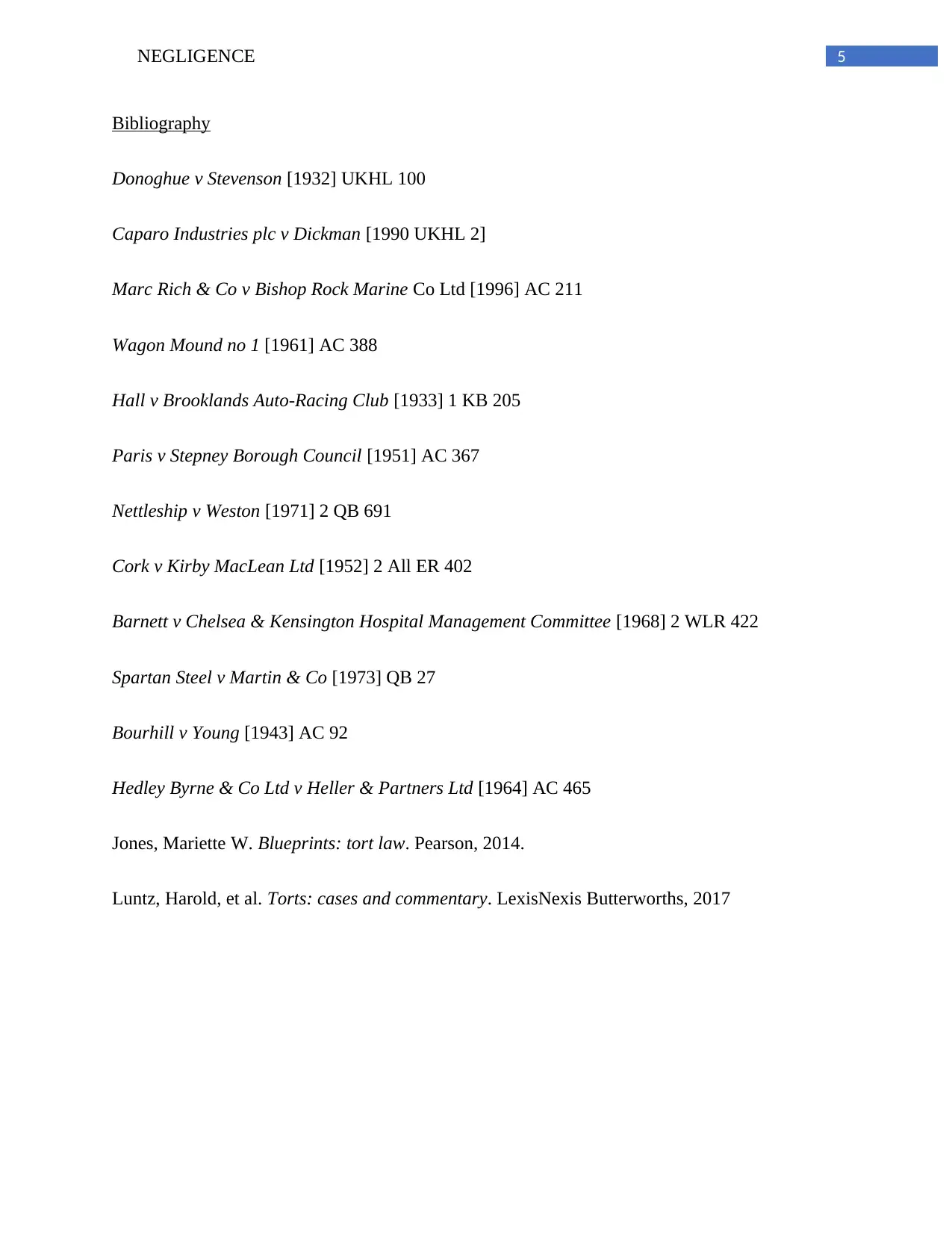
5NEGLIGENCE
Bibliography
Donoghue v Stevenson [1932] UKHL 100
Caparo Industries plc v Dickman [1990 UKHL 2]
Marc Rich & Co v Bishop Rock Marine Co Ltd [1996] AC 211
Wagon Mound no 1 [1961] AC 388
Hall v Brooklands Auto-Racing Club [1933] 1 KB 205
Paris v Stepney Borough Council [1951] AC 367
Nettleship v Weston [1971] 2 QB 691
Cork v Kirby MacLean Ltd [1952] 2 All ER 402
Barnett v Chelsea & Kensington Hospital Management Committee [1968] 2 WLR 422
Spartan Steel v Martin & Co [1973] QB 27
Bourhill v Young [1943] AC 92
Hedley Byrne & Co Ltd v Heller & Partners Ltd [1964] AC 465
Jones, Mariette W. Blueprints: tort law. Pearson, 2014.
Luntz, Harold, et al. Torts: cases and commentary. LexisNexis Butterworths, 2017
Bibliography
Donoghue v Stevenson [1932] UKHL 100
Caparo Industries plc v Dickman [1990 UKHL 2]
Marc Rich & Co v Bishop Rock Marine Co Ltd [1996] AC 211
Wagon Mound no 1 [1961] AC 388
Hall v Brooklands Auto-Racing Club [1933] 1 KB 205
Paris v Stepney Borough Council [1951] AC 367
Nettleship v Weston [1971] 2 QB 691
Cork v Kirby MacLean Ltd [1952] 2 All ER 402
Barnett v Chelsea & Kensington Hospital Management Committee [1968] 2 WLR 422
Spartan Steel v Martin & Co [1973] QB 27
Bourhill v Young [1943] AC 92
Hedley Byrne & Co Ltd v Heller & Partners Ltd [1964] AC 465
Jones, Mariette W. Blueprints: tort law. Pearson, 2014.
Luntz, Harold, et al. Torts: cases and commentary. LexisNexis Butterworths, 2017
1 out of 6
Related Documents
Your All-in-One AI-Powered Toolkit for Academic Success.
+13062052269
info@desklib.com
Available 24*7 on WhatsApp / Email
![[object Object]](/_next/static/media/star-bottom.7253800d.svg)
Unlock your academic potential
© 2024 | Zucol Services PVT LTD | All rights reserved.





